The Netherlands is known for its cheese, and you can buy Dutch cheese worldwide. The Netherlands is even the second-largest cheese producer globally, which is remarkable for such a tiny country.
Discover why cheese is such an essential part of Dutch culture
I answered the 11 most asked questions about Dutch cheese to help you discover why cheese is such an essential part of Dutch culture.
Dutch Cheese
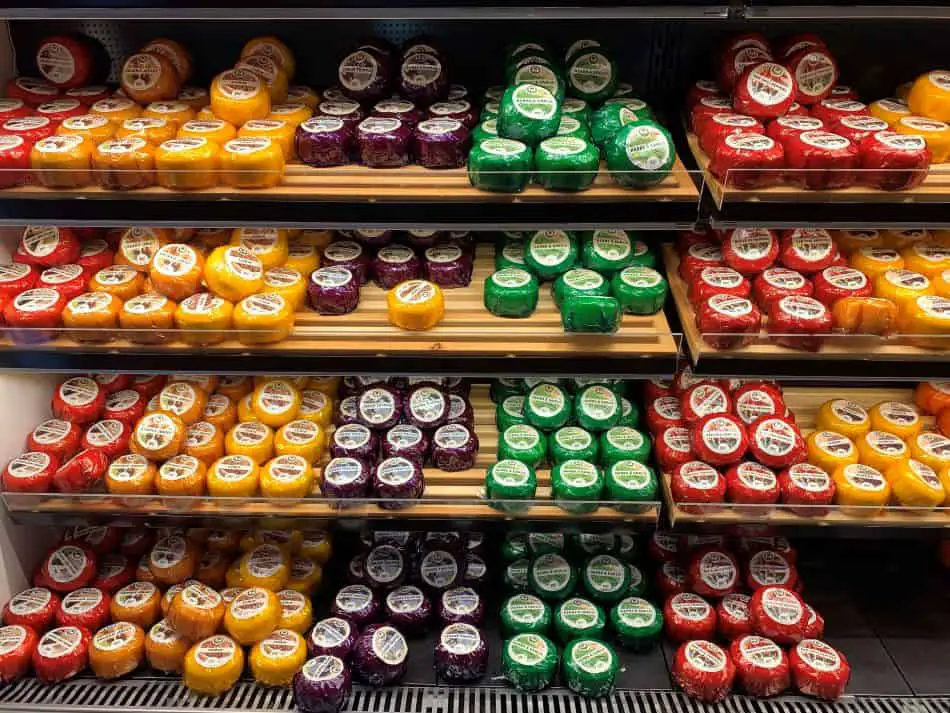
This article focuses on Dutch cheese, but I have answered more general questions about Dutch food in another article on this website.
1. Why Is The Netherlands Known For Its Cheese?
Cheese is made all over the world and not just in The Netherlands. So, why is it that the Netherlands is known for its cheese?
In the past, Dutch merchants sailed worldwide to trade goods, among them Dutch cheese. Dutch cheeses are waxed and have a long shelf life, making them ideal for trading. That is how The Netherlands became known for its cheese.
The reason that The Netherlands is known for its cheese is not just the cheese itself, even though it is delicious cheese. It is the combination of the product and the worldwide spread of Dutch cheese by Dutch merchants. The Dutch understood marketing before marketing was coined as a word.
The Netherlands is also known for wooden shoes; the parallel between wooden shoes and Dutch cheese is obvious. Dutch merchants also traded these wooden shoes worldwide for other goods. Hence, people worldwide associate wooden shoes with the Dutch, as with cheese.
2. How much cheese does the Netherlands produce annually?
The Netherlands is one of the largest producers and exporters of cheese globally. As a result, you can buy Dutch cheese all over the world. That is remarkable for such a small country. So, how much cheese does the Netherlands produce annually?
The Netherlands produces almost 900 million kg of cheese annually and exports most of it. The value of Dutch dairy exports is almost € 8,0 bln (US$ 9,5 bln) annually.
The Netherlands produces this much cheese out of necessity since only grass grows well at their low-lying, soggy farmland below sea level.
An annual production of almost 900 million kg of cheese makes The Netherlands the sixth largest cheese producer in the world.
Cheese production is an excellent example of how the Dutch made the best of their soggy farmland because they had no other option. So, the Dutch must have done something right if this wet farmland became a global dairy export powerhouse.
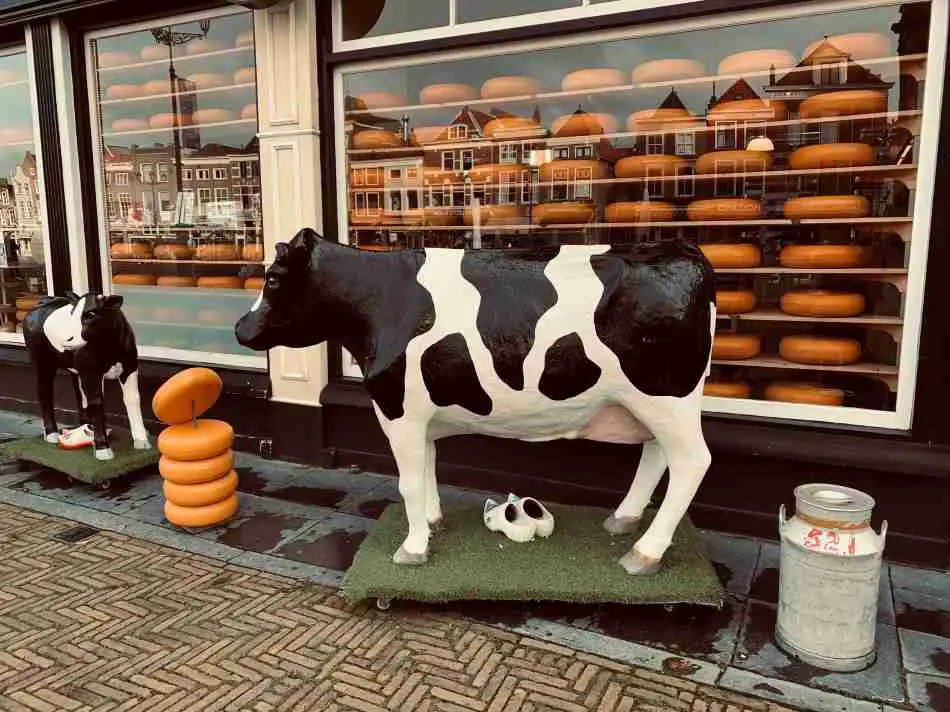
3. Where Is Dutch Cheese Produced?
You may wonder where in the Netherlands the Dutch produce their cheese.
Dutch cheeses are produced in the west of The Netherlands. The farmland in the west is soggy, and wheat and corn do not grow well on wet farmland. Grass, however, grows very well on soggy farmland and consumes a lot of water, which makes the farmland drier and firmer.
That is why the western polders in The Netherlands are covered with grass and occupied by millions of cows. Farming in the west of The Netherlands is almost exclusively focused on milk production. Thus, the Dutch have optimally used their low-lying soggy farmland conditions and turned a disadvantage into an advantage.
Farming in this western part of The Netherlands has become very intensive, with almost 1,6 million cows producing milk in its green meadows. That is a lot of cows if you realize that the Netherlands has only 17 million inhabitants.
Cheese, wine and friends
Must be old to be good
A cow produces around 7000 liters of milk annually. Therefore, the annual milk production of these 1,6 million cows in The Netherlands is a staggering 11,2 billion liters.
You need ten liters of milk to produce one kilogram of cheese. Thus, the annual cheese production of 900 million kilograms requires approximately 9 billion liters of milk. Hence, most milk production in The Netherlands is used to produce cheese.
The annual Dutch cheese production is almost exclusively exported, and The Netherlands is one of the top global exporters of dairy products like cheese, butter, and milk. The value of Dutch dairy exports exceeded Euro 7,7 billion in 2019.
4. How Is Dutch Cheese Made?
The traditional way to make cheese in The Netherlands consists of the following four steps and can take up to two years, depending upon the length of the ripening process.
- Pasteurization and adding rennet
- The cow milk is pasteurized before rennet is added and mixed. The milk proteins will coagulate in ± 30 minutes, forming a solid curd. The liquid (whey) is removed and used as fertilizer. The curd is then washed with warm water before being put into molds.
- Squeezing the curd
- The curd is put into a round mold and firmly squeezed to remove as much liquid as possible. This squeezing will take a couple of hours if done traditionally.
- Salting
- As a next step, the Dutch cheese is salted in a brine bath for five days before drying for another 24 hours. This salting bath gives a taste to the cheese and improves its shape and texture. It also increases the shelf life of the cheese.
- Ripening
- The taste of the cheese depends on its maturation, usually between 1 and 24 months. The longer the cheese matures, the spicier the flavor will become.
I recommend watching this excellent YouTube video to understand the traditional Dutch cheese production process in more detail. The video is about cheese production on a 100-year-old farm near Gouda in The Netherlands. This video has been watched over 13 million times in about two years.
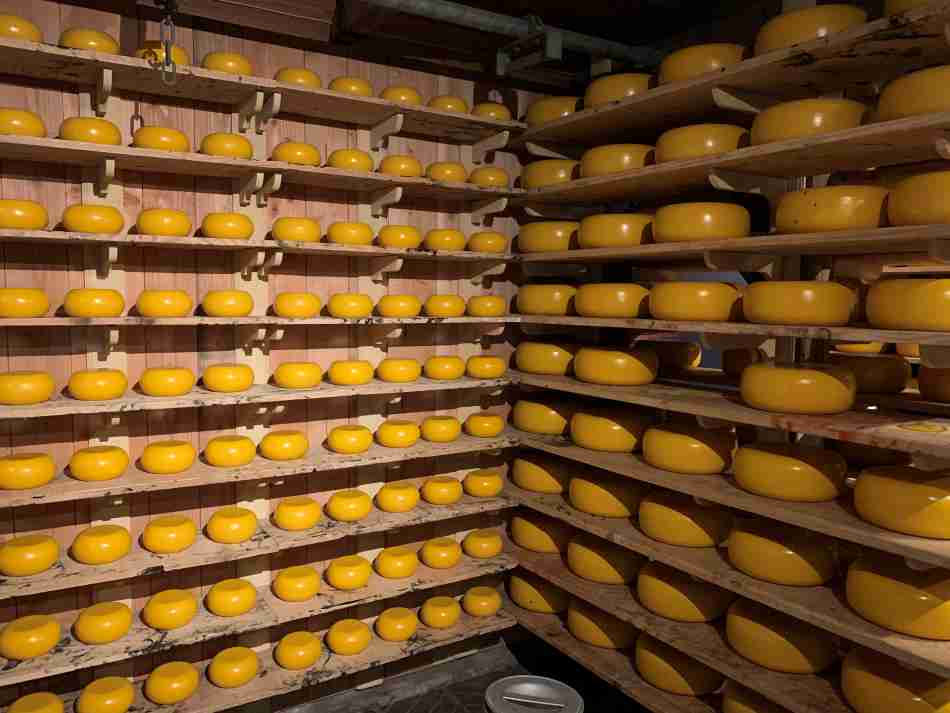
5. Other Questions About Dutch Cheese
Are Dutch cheeses pasteurized? Nowadays, hard Dutch cheeses are all made of pasteurized cow milk. The label on the cheese should indicate that the milk is pasteurized so that you can verify that before buying the cheese.
Is Dutch cheese vegetarian? One would assume that Dutch cheese is the quintessential vegetarian product. However, that is not necessarily the case because it depends on the rennet’s source used in the Dutch cheese production process. Natural rennet from the stomachs of calves is most commonly used. Fortunately, other types of rennet are also used, and you must do your research as a vegetarian to find 100%-vegetarian cheese.
Is Dutch cheese gluten-free? Dutch cheese is gluten-free. However, cheese spreads and cheese with added herbs may contain gluten. If so, the label on these cheese products must contain information about the presence of gluten. Check the label carefully if the absence of gluten is essential for you.
Why is Dutch cheese yellow? Dutch cheese is made from cow milk, which contains the yellow substance carotene. This carotene ends up in cheese, giving the cheese its yellow color. In contrast, goat cheese is white because goats convert carotene into vitamin A, which is colorless.
6. Can I Visit A Traditional Dutch Cheese Farm?
Another fun option is to visit a cheese farm and see how cheese is produced.
- Visit a cheese farm in the neighborhood of Amsterdam.
- Excellent overview with links to websites of 10 cheese farms in the neighborhood of Gouda
- Visit the website of Cheese Valley to discover more options to visit cheese farms in the neighborhood of Gouda and Woerden.
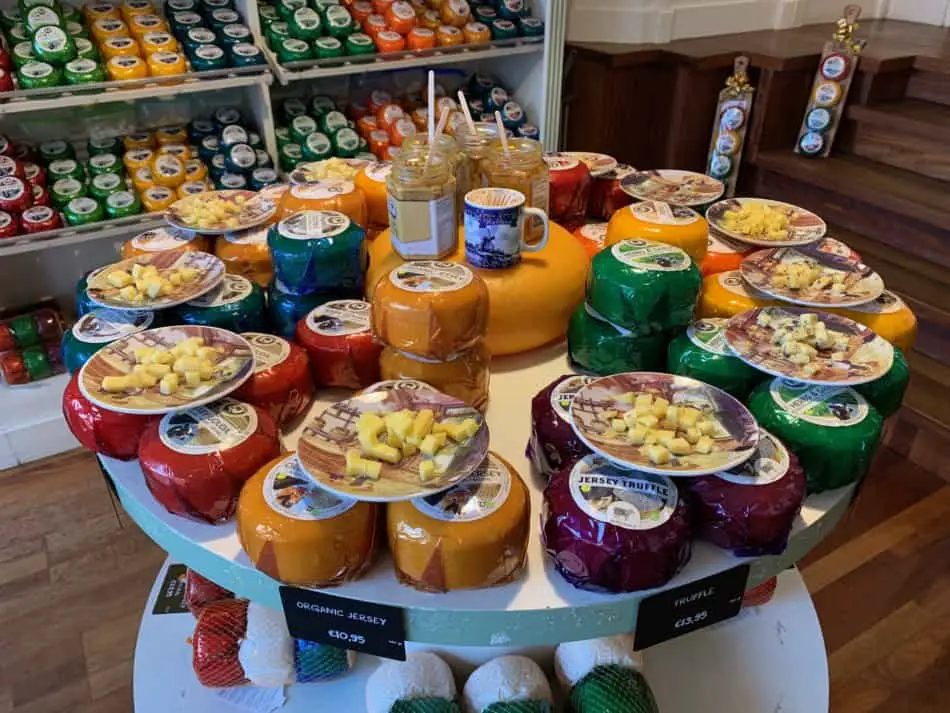
7. What Are Famous Dutch Cheeses
Cheese is made out of milk, and its taste depends mainly on the quality of the milk. Natural factors such as climate, the quality of the local soil, and the grass used for feeding the cows play a significant role in determining the milk’s quality and taste and, therefore, the cheese.
For example, the meadows in North Holland are surrounded by sea. Therefore, the cows in North Holland produce richer, creamier milk than elsewhere in The Netherlands.
Dutch cheeses are often named after cities or regions. If cheese is named after a town, this town used to have a cheese market. For example, Gouda cheese is named after Gouda, with its long-standing history of a flourishing cheese market.
- Gouda
- Gouda cheese has the shape of a wheel, weighs between 1-15 kg, and is a fragrant, tasty cheese. Gouda cheese is available in different stages of aging: young, mature, and old.
- Gouda North-Holland
- Gouda North-Holland is richer and creamier at a young age than regular Gouda cheese. It gets a more intense flavor at an older age and becomes sweeter and fruitier. North-Holland Gouda is also less salty and more crumbling than regular Gouda.
- Old Amsterdam
- Old Amsterdam is a Gouda North-Holland cheese variety. The name “Old Amsterdam” is chosen for marketing reasons because Amsterdam is a well-known name.
- Edam
- Edammer cheese can be recognized by its typical round shape, red color, and relatively small size. In addition, Edammer cheese has a very accessible and creamy taste and does hardly smell.
- Leerdam
- The taste of Leerdammer cheese resembles that of Emmenthaler cheese, although Leerdammer cheese has a somewhat rounder taste. Leerdammer cheese has mild, sweet, and nutty flavors, which increase with aging.
- Beemster
- Beemster cheese has a typical soft and delicate taste. The more Beemster cheese ages, the saltier it becomes. Beemster cheese can age for almost a year.
- Friese nagelkaas
- Frisian nagelkaas is a cheese made from skimmed milk to which cumin and cloves are added. The cheese is firm, flattened, and has sharp corners.
- Leidse Kaas
- Leiden cheese is a type of cheese with cumin. The texture of Leiden cheese is firm because it contains less fat than most other Dutch cheeses.
I have written another article about how good Dutch wines are, in case you want to try a Dutch wine with your Dutch cheese.
8. Is Dutch Cheese Healthy?
Dutch Cheese is often touted as good for you and one of the healthiest food products.
Cheese contains essential nutrients like calcium, vitamin B12, vitamin D, and amino acids. However, cheese also has quite a lot of saturated fat and salt. Hence, cheese is only healthy with moderate consumption.
Fortunately, tasteful cheeses with lower fat levels are also becoming widely available, providing a healthier alternative.
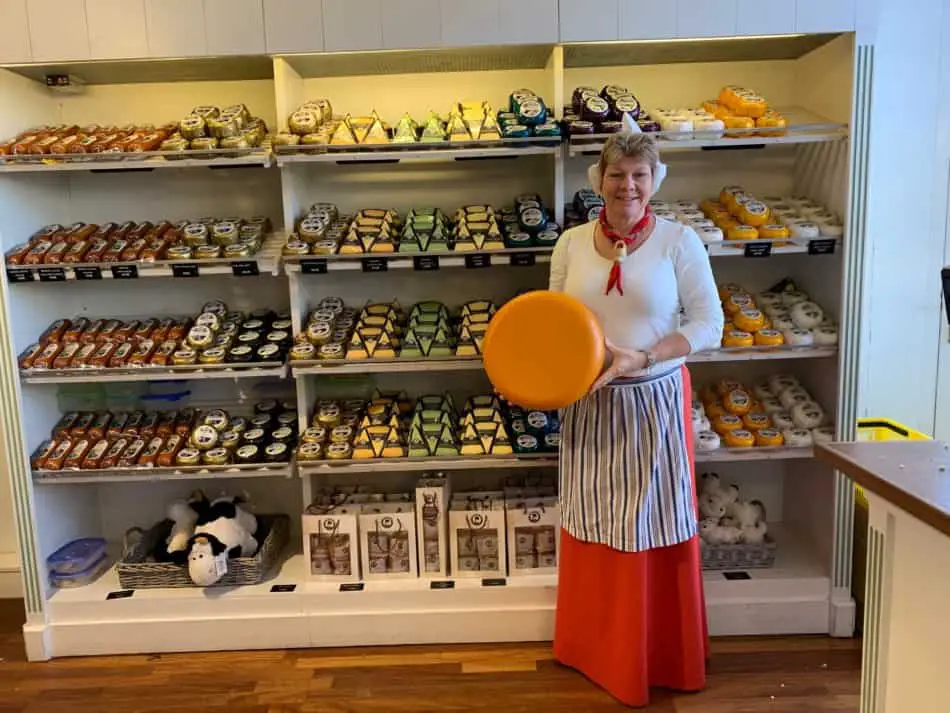
9. Are The Dutch Tall Because Of Cheese?
The Dutch are the tallest people in the world, and the internet is full of articles claiming they are so tall because of their cheese. The pseudo-scientific rationale behind this claim is that high calcium levels in cheese stimulated the bone growth of Dutchmen.
The Dutch are unlikely to be so tall due to their cheese because their cheese consumption is moderate compared to less tall populations. In addition, the Dutch continued growing when the height in other populations leveled off, while cheese consumption did not change.
The Dutch eat 20 kilograms of cheese per person annually, just enough to secure a top 10 position of cheese-eating countries in Europe. The large majority of Dutch cheese is exported worldwide.
The reason the Dutch are so tall is a combination of three complementary factors.
- High living standards allowed the Dutch to afford high-quality nutrition
- Excellent health care prevented many childhood diseases.
- Tall Dutch men and women have relatively more children, increasing average heights.
High-quality nutrition involves much more than eating cheese.
10. Where Are Dutch Cheese Markets?
Visiting a cheese market is a fun day trip and highly recommended.
There are still five cheese markets in the Netherlands. These five Dutch cheese markets occur in Gouda, Alkmaar, Edam, Hoorn, and Woerden once every week during summertime.
At the markets of Gouda and Woerden, actual genuine trading in cheese still takes place. The other three cheese markets are tourist attractions but are worth visiting to experience a bit of Dutch culture with a long history.
If you want to visit one of these five cheese markets, click one of the links below to discover when they occur.
These cheese markets are ideal for experiencing old-fashioned Dutch folklore and trying out the different Dutch cheese varieties. So if you are looking for a fun day trip from Amsterdam, the cheese market of Alkmaar is the easiest one to reach.

11. Where Are Dutch Cheese Museums?
You can also visit various cheese museums in The Netherlands.

